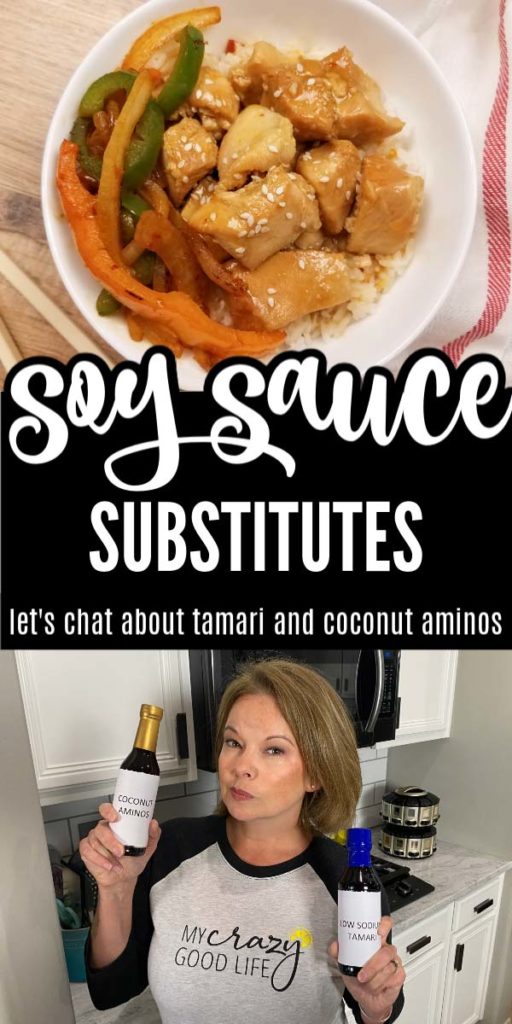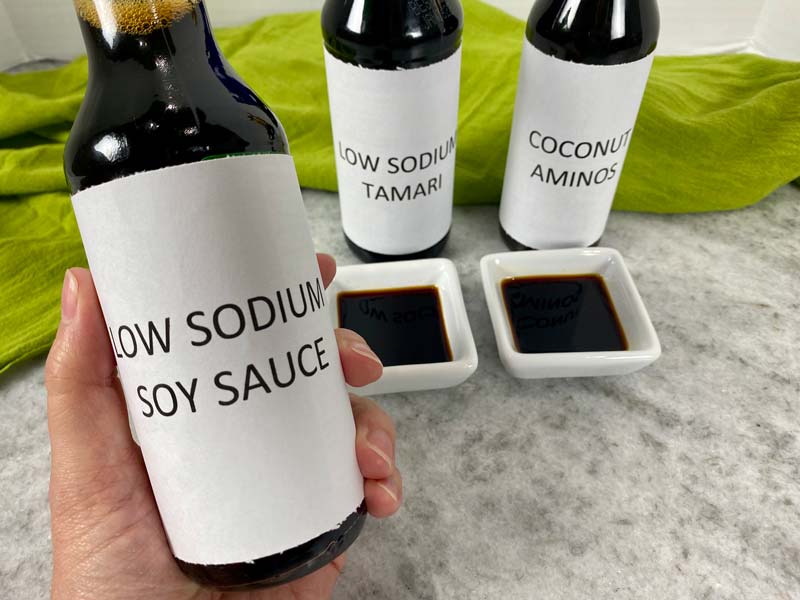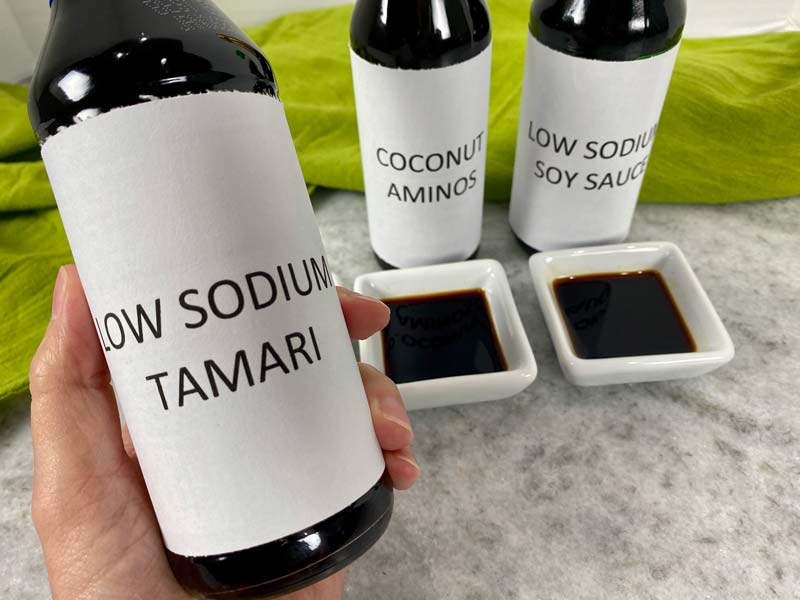This site contains affiliate links. Please see Policies for more information.
Some popular soy sauce substitutes are Tamari and Coconut Aminos. If you’ve never heard of these products and are wondering if they’re right for your kitchen, read on!
I use these products a lot in my recipes and wanted to explain the difference between them. I’m comparing three things: sodium, taste, and gluten.

I think part of a healthy lifestyle is understanding the ingredients we use in the kitchen and how they impact our bodies.
As I’ve been learning through research and my nutrition education, I’ve been sharing more nutrition focused information with my readers.
- Processed Oils: Which Ones Are Healthy
- What to Look For In Stevia
- What is Nutritional Yeast?
- What are artificial sweeteners?
Why would I want a soy sauce alternative?
Traditional soy sauce is high in sodium. It also contains wheat and soy, which are common allergens. Also, soy products are typically highly processed.
Soy Sauce Substitutes Compared To The Real Thing:
We’re going to take a look at a few alternatives and how they compare to the low sodium version. I’ll show you the difference between their taste, how much sodium they have, and what’s what with their gluten and soy content.

Soy Sauce
- Taste: Regular soy sauce is salty, a little sweet, and a bit bitter. It’s a thin sauce that is used frequently in Chinese cooking. If you have a soy allergy, it’s a no-go, as it usually contains GMO soy.
- Sodium: Typical varieties have about 960 mg of sodium per 1 tablespoon. That’s almost 40% of the recommended daily value for sodium. The low sodium type contains about 575mg of sodium per tablespoon.
- Gluten: Wheat is added to most soy seasoning sauce. Its’ actually made by combining wheat and soy and allowing them to ferment, so there is gluten in most of them. Because of this, it doesn’t have a place in a gluten free diet.

Tamari
Tamari is a great soy sauce substitute. It’s my family’s go-to substitute, and I think the flavor is so much better. Tamari is a gluten free option.
Tamari is a thicker Japanese cooking sauce that is made without wheat. It uses a fermented soybeans, water, and sea salt to achieve a similar flavor to that of Chinese soy sauces, and still has that dark soy sauce look.
- Taste: Tamari is a smoother tasting alternative with less vinegar flavor.
- Sodium: There is about 940 mg of sodium in regular tamari, and 700 mg of sodium in 1 tablespoon of low sodium tamari sauce. That’s about 29% of the daily value recommended for sodium on most diets.
- Gluten: Tamari sauce does not typically contain any gluten because the fermentation process is not completed with wheat products.
In my opinion, tamari is the tasting best alternative out there. It gives us a delicious flavor that’s lower in sodium and it’s less processed.
Is tamari healthier than soy sauce?
Tamari is considered healthier for a few reasons. It is typically lower in sodium than soy sauce, it’s a fermented food, and it contains less ingredients.

Want to Save This?
Liquid Aminos and Coconut Aminos
Liquid aminos are another gluten free and soy free soy sauce alternative that you might have heard about. They contain amino acids but have much more sodium than coconut aminos.
Coconut aminos are a gluten and soy free soy-sauce alternative that is much lower in sodium than other options. They are also non GMO, don’t contain MSG, and they’re vegan.
What is coconut aminos?
Coconut aminos are a popular ingredient in healthy Asian food recipes. It looks and tastes similar to soy sauce. They are made by fermenting sap from coconut blossoms, sea salt, and water. A popular brand is Coconut Secret.
Coconut aminos do not taste like coconut. The coconut has given us a ton of healthy ingredient substitutes–in addition to aminos, we use coconut flour and coconut sugar (also called coconut palm sugar) in our house weekly.
They contain no wheat, GMOs, MSG, or extra sodium. The term aminos refers to the 17 amino acids it includes. Our bodies need amino acids to build and maintain muscle.
- Taste: Coconut aminos taste like soy sauce, but with less sodium. It does not taste like coconut at all. Most people would describe the taste as mild.
- Sodium: There are about 270 mg of sodium in 1 tablespoon of coconut aminos. You read that right–270mg vs. 575mg and 700mg for soy sauce and tamari.
- Gluten: They’re are naturally vegan and gluten free. They’re a great substitute.
Are liquid aminos healthy?
Some people consider liquid aminos healthy because they contain many amino acids, but as you’ll see above, so do coconut aminos. I’d recommend anyone using liquid aminos substitute coconut aminos to reduce sodium.
Liquid aminos are still high in sodium (960 mg per tablespoon), and they contain both wheat and soy. The only plus is that they contain about 2 grams of protein per tablespoon–but so does tamari.

Soy Sauce vs Tamari vs Coconut Aminos
I prefer the taste of tamari, and the low sodium and ingredients in coconut aminos. Many times I’ll mix the two together for the best alternative for our family.
If you’re looking to use coconut aminos as a substitute for soy sauce, it’s a one to one swap–use the same amount for any substitute.
How to use soy sauce alternatives:
Soy sauce alternatives can be used in stir fries, as a topping for Chinese foods, like this Instant Pot orange chicken recipe, and as a dipping sauce for things like sushi, sashimi, and more.
Soy sauce can sometimes be replaced by things like salty umami, fish sauce, or even balsamic vinegar, Worcestershire sauce, or beef bouillon and beef broth. There are plenty of ways to experiment with alternatives that provide a similar flavor profile.
You can find all of these alternatives in your local grocery store’s Asian food aisle or right on Amazon.
Delicious recipes using these soy sauce substitutes:
- Drunken Noodles
- Cauliflower Fried Rice
- Egg Roll Wonton Cups
- Egg Drop Soup with Chicken
- Chicken Lo Mein
- Breakfast Fried Rice
- Vegetarian Pad Thai with tofu
- Orange Chicken
Soy sauce substitutes can help reduce your sodium intake and remove both gluten and soy from your diet. If you’re avoiding soy sauce, Tamari is a substitute that contains fewer ingredients and has a better taste. Coconut aminos have no soy or gluten and much less sodium than soy sauce or tamari.











One of the best blog posts ever. Bookmarked for the future!
Hi Sharon, when you blend coconut aminos and tamari what are your proportions? Half and half? Straight tamari is too salty for me and I don’t like the flavor of straight coconut aminos. A blend would be perfect.
What do you suggest?
Thank you,
Carol
I usually do half and half, I’d start there. After doing it a few times I bet you’ll find your perfect ratio! :)
Can coconut aminos or tamari be substituted in equal measurements to soy sauce? For example: A marinade recipe calls for 1/4 cup of soy sauce, do I use the equivalent amount of the others in it’s place?
Hi Sharon, Yes! Soy sauce, coconut aminos, and tamari are easily swapped out for the same amount!
Am I understanding correctly, liquid aminos aren’t fermented, but the coconut aminos are?
Correct! Liquid Aminos are not fermented.